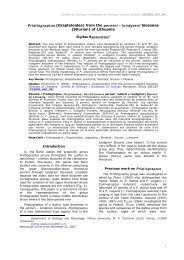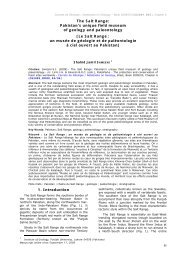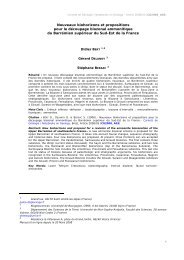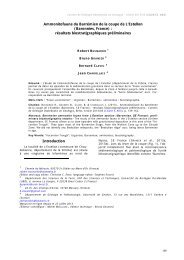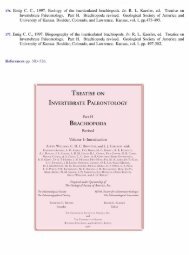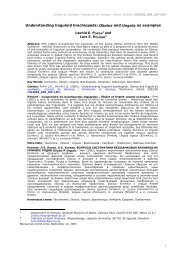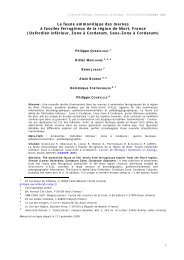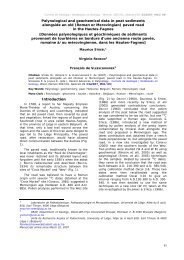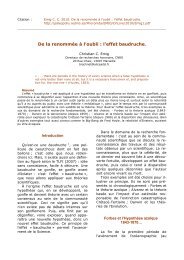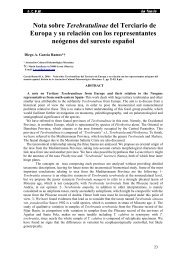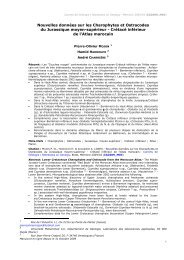Les dépôts continentaux du Jurassique moyen au Crétacé inférieur ...
Les dépôts continentaux du Jurassique moyen au Crétacé inférieur ...
Les dépôts continentaux du Jurassique moyen au Crétacé inférieur ...
You also want an ePaper? Increase the reach of your titles
YUMPU automatically turns print PDFs into web optimized ePapers that Google loves.
limestone with Porochara maxima (dét. P.-O.<br />
MOJON), a species characteristic of the uppermost<br />
Tithonian-Lower Berriasian (MOJON,<br />
1989b, 2002).<br />
3. The "Red Beds" of Barremo?-Aptian to<br />
Cenomanian age: the Dekkar Group (Plate 3)<br />
The Dekkar Group (HADDOUMI, 1998) is made<br />
up of three formations with a total thickness of<br />
about 500m.<br />
The Dekkar 1 Formation is essentially<br />
conglomerates with calcareous elements and<br />
calcarenites that lie discordantly (D2, mapping<br />
disconformity) on several underlying formations.<br />
The polygenic nature of the materials and<br />
their discordant relationships (Fig. 1C) denote a<br />
morpho-tectonic evolution of the region with<br />
erosion of structures ranging up to Liassic in<br />
age. Laterally toward the north, these deposits<br />
grade to a lacustrine assemblage, the "Ain<br />
Mellouk Limestone" (<strong>du</strong> DRESNAY, 1956;<br />
BOUCHTA, 1967; CAÏA, 1972). It contains<br />
ostracodes (Pl. 4, figs. 12-21) and charophytes<br />
that date it Aptian (FEIST et alii, 1999).<br />
The Dekkar 2 Formation (Fig. 5) was laid<br />
down in a fluvial-lacustrine environment evolving<br />
in the course of time toward an evaporitic<br />
coastal plain. Limestone lentils contain bivalves<br />
and ostracodes (Pl. 4, figs. 1-11). The several<br />
ostracode associations (dét. B. ANDREU)<br />
collected from the "Ain Mellouk Limestones" and<br />
in the "Dekkar 2 Formation are typical of freshwater<br />
environments with a salinity ranging<br />
between 0 and 0.5‰, those of the Lower<br />
Cretaceous Wealden facies of Europe and<br />
Morocco.<br />
The Dekkar 3 Formation was deposited in an<br />
evaporitic sabkha environment until replaced by<br />
the installation of the carbonate platform of<br />
which the initial deposits were marine limestones<br />
with Rhapidioninae of Late Cenomanian<br />
age, but that do not include its terminal strata.<br />
III. Paleogeographic evolution<br />
The paleogeographic evolution of this area,<br />
located at the juncture of the High Plate<strong>au</strong>x to<br />
the north and the folded High Atlas in the<br />
south, is synthesized on Figs. 6 and 7.<br />
1. Filling of the Tethyan Atlasic gulfs <strong>du</strong>ring<br />
the Bathonian<br />
In the eastern High Atlas, the megasequence<br />
S1 is equivalent in age to the time <strong>du</strong>ring which<br />
the Jurassic carbonate platform existed and<br />
ended with the appearance of a fluvio-deltaic<br />
cycle (Anoual Formation). Its spatiotemporal<br />
relationships are<br />
molded by the structural<br />
Carnets de Géologie / Notebooks on Geology - Article 2008/06 (CG2008_A06)<br />
elements of the preceding Jurassic period that<br />
were dominated by two main families of f<strong>au</strong>lts<br />
(Fig. 6): one of them (F1, F1', F1'') oriented<br />
SW-NE to WSW-ENE and the other (F2, F2')<br />
oriented WNW-ESE to E-W. The deposits are<br />
confined to the Anoual and Ksar Jilali blocks and<br />
are contemporaneous with an important play on<br />
f<strong>au</strong>lts F2 and F2' and secondarily on the F1".<br />
The W-E trend of the shoreline (Fig. 6A)<br />
indicates the persistence of movement on f<strong>au</strong>lts<br />
F2 and F2', at the time of the Early Bathonian<br />
transgression attributable to the transgressive<br />
portion of a 3rd order eustatic cycle Bat1<br />
(HARDENBOL et alii, 1998).<br />
In the central High Atlas, the Guettioua<br />
Formation (JENNY et alii, 1981) is an important<br />
continental detrital body, it too ending the<br />
middle Jurassic regression.<br />
In the Middle Atlas, there is an analogous<br />
evolution in the sediments. There, the<br />
megasquence S1 ends with the El Mers<br />
Formation (<strong>du</strong> DRESNAY, 1963b) that marks the<br />
filling of the Middle Atlas trough. However, the<br />
dating Late Bathonian-?Callovian for the last<br />
marine recurrence (CHARRIÈRE et alii, 1994)<br />
indicates that the sea persisted in the Middle<br />
Atlas gulf after the High Atlas gulf had closed.<br />
The filling of the Tethyan Atlasic gulfs in the<br />
central and eastern portions of the Atlasic<br />
domain took place in an active tectonosedimentary<br />
context that ended with an<br />
increase in the intensity of subsidence <strong>du</strong>ring<br />
the Bathonian.<br />
2. The period of emergence (Middle Jurassic<br />
pro parte, Late Jurassic - Early Cretaceous pro<br />
parte).<br />
In the eastern High Atlas, a new continental<br />
sequence, S2, was laid down <strong>du</strong>ring the latest<br />
Tithonian-Early Berriasian after a hiatus in sedimentation<br />
of about 20Ma. The resi<strong>du</strong>al deposits<br />
of this second fluvio-deltaic cycle are restricted<br />
(Fig. 6B) to blocks subsident <strong>du</strong>ring the<br />
Bathonian period. This megasequence was<br />
probably deposited in a valley incised <strong>du</strong>ring a<br />
lowering of sea level in a eustatic cycle<br />
associated with the end-Jurassic regression<br />
(HARDENBOL et alii, 1998). This second deltaic<br />
cycle was followed by a second interruption in<br />
sedimentation (D2) that lasted in the<br />
neighborhood of 20 Ma.<br />
Figure 2 : Colonne stratigraphique synthétique et<br />
évolution séquentielle des "Couches rouges" dans les<br />
environs d'Anoual.<br />
Synthetic stratigraphic log and sequential evolution of<br />
the "Red Beds" near Anoual.<br />
4



